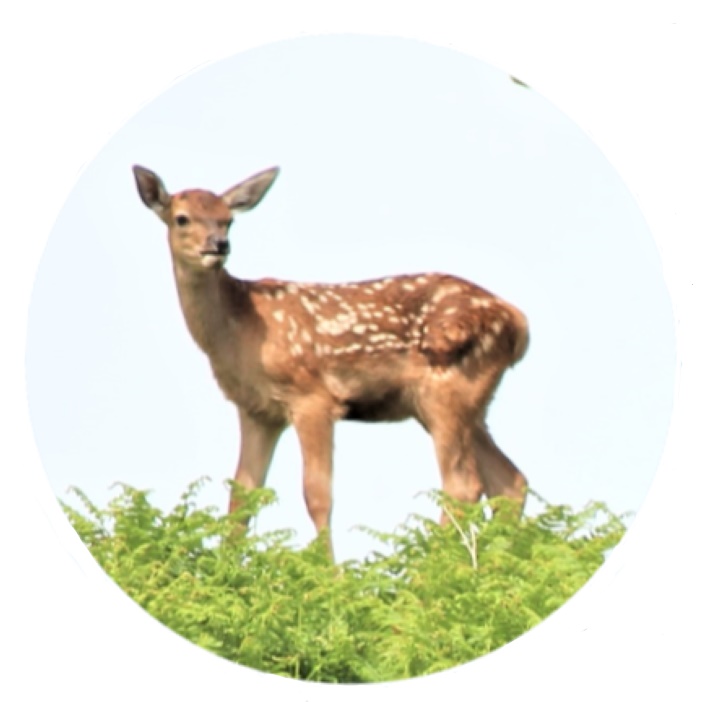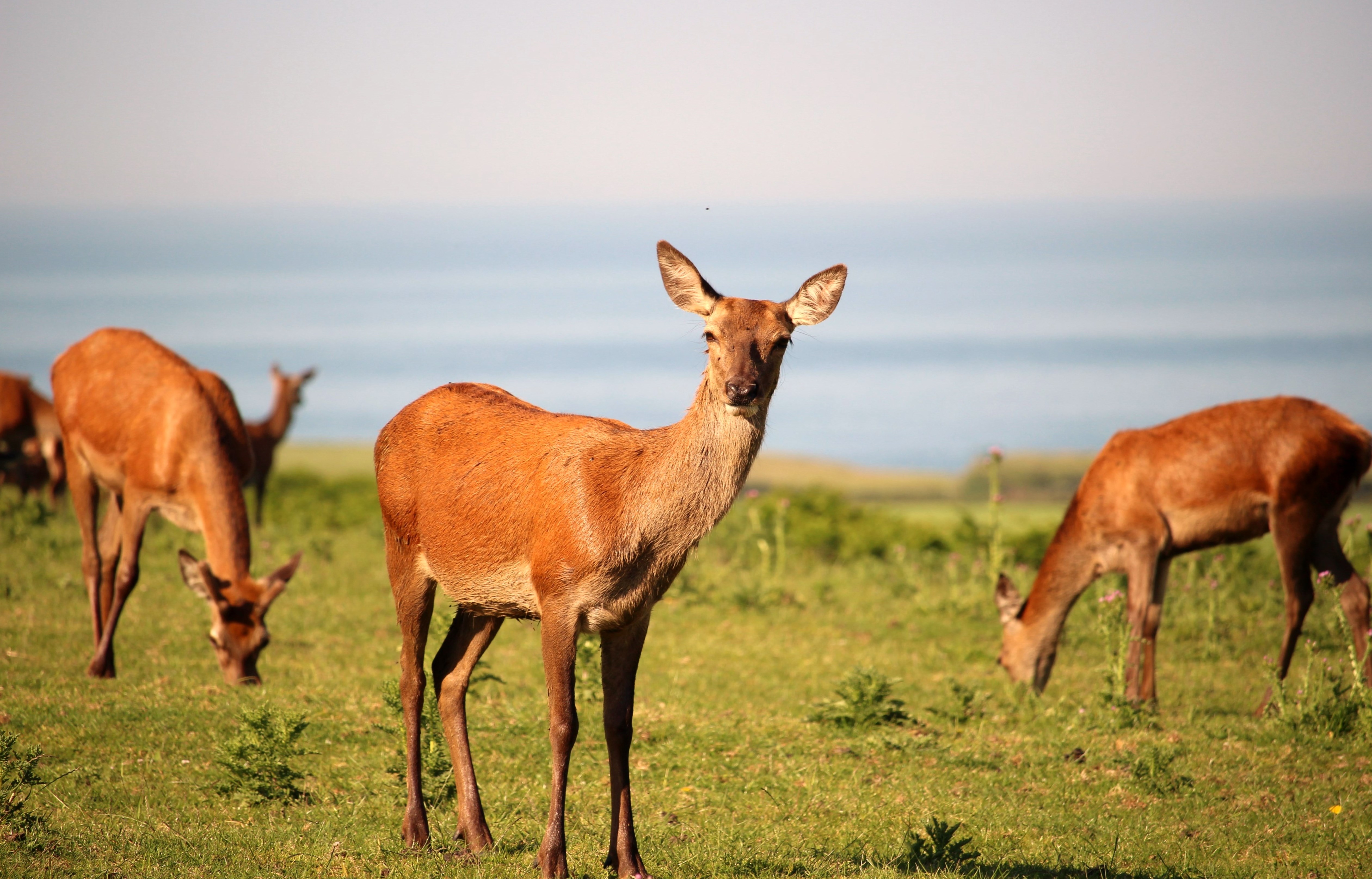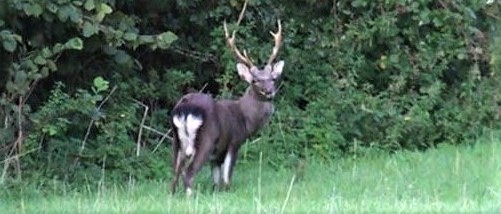
Red deer hind & calf – Isle of Wight
The Isle of Wight Forest Design Plan
In 2017 the Forestry Commission launched a consultation on their Isle of Wight Forest Design Plan, this is how we responded:-
The Isle of Wight’s rich woodlands evolved in presence of wild deer1,2,3,4, , in common with much of southern England these deer populations declined during the 18th century and had disappeared by the mid 19thcentury, only to re-emerge again in the late 20th century. On the mainland these re-emerging deer have descended from a mixture of escapees from captivity, re-introductions and the natural spread of wild deer, the same appears to be true of the island’s deer. There is no evidence to support claims that there are no naturally occurring deer on the island16.
Of the five deer species 17that have been seen on the island in recent years both the Red and Roe have the distinction of being amongst the island’s scarcest native woodland mammals.
Scientific research including that done by the Forestry Commission indicates that both having too many and too few deer is detrimental to biodiversity 5,6,7,8. There is circumstantial evidence that despite the richness of our woodlands we may be slowly losing both flora and fauna species* as a result of the relative scarcity of deer. To give but one example some of the woodland birds that are quite commonly found in the New Forest have been described as “curiously absent” from the Isle of Wight9. Scientific research illustrates the beneficial interactions of deer activity with these birds10,11 .

Tawny Owls are scarce on the Isle of Wight, possibly due to insufficient deer grazing activity
The Isle of Wight Forest Design Plan sets itself the objective:-
“To maintain and enhance the favourable conservation status of a naturally important wildlife site”.*
Heathland, Acid Grassland and Wood Pasture are mentioned as priority habitats and the Design Plan acknowledges that many of these were once grazed by deer. These grazing activities helped to maintain floral diversity and aid seed dispersal.
IW Deer Conservation believes that wild deer have a role to play in maintaining these priority habitats in the future as they have done in the past.
Both the IW Forest Design Plan and South England Forest Deer Management Strategy make various claims pertaining to the absence of deer being of benefit to our unique flora and fauna*, however scientific research indicates that this is not true, and that woodland biodiversity decreases when deer are not present. Both historical and archaeological records indicate that wild deer and the rest of the island’s unique flora and fauna flourished together over thousands of years in our rich woodlands. Claims that any deer present on the island have posed a threat to this unique ecology appear to be without foundation.

Science tells us that biodiversity benefits from at least some deer activity – Source: Forestry Commission FB 18
IW Deer Conservation believes that the biological diversity of the islands woodlands would be best served by the sustainable management of our local deer with the presence of native deer species being prioritised.
The Forestry Commission claim that:-
“Our overall objective for deer management, in line with Government’s aim in England is to maintain a well-managed and healthy deer population, which presents no threat to long term environmental, social or economic sustainability, and to limit as far as is practical, the further spread of recently introduced species”.
Whilst Defra have set out the terms of reference for the management of deer on the public estate12 and have stated that:-
“The Defra family will continue to manage deer populations on public land at sustainable levels, ensuring best practice at all times”
They have further stated that:-
“Defra policy on wild deer management applies equally across England, and the Isle of Wight is no exception18.”
The Deer Initiative publishes these best practice guides which together with their Vision Statement and Accord set out these minimum acceptable standards for deer management.

Best Practice applies at all times to publicly owned land on the Isle of Wight (source: Defra)
The Isle of Wight is a geographically self-contained area which restricts cross-Solent deer migration, the Forestry Commission claim to have successfully controlled both native and naturalised deer species on the island in the 20th century and to have received widespread support from landowners for doing so. This together with reference to the past history of wild deer on the island indicates that landscape scale deer management for these species is entirely feasible here.
However, it would appear that persecution of these native deer in an ill-conceived attempt to establish the Isle of Wight as a long term experimental deer free zone13,14,15 may have merely widened the ecological niche for the island’s Muntjac deer to expand into.
Neither the Isle of Wight Forest Design Plan nor the South England Forest Deer Management Strategy (17.Isle of Wight) are compliant with Defra policy, the Forestry Commission’s own policy for the rest of southern England, and the principles set out in the Deer Initiative’s Best Practice, Accord and Vision statements.
This is unacceptable, both the IW Forest Design Plan and South England Deer Management strategy (17.Isle of Wight) clearly need to be urgently revised.
We believe that it will be beneficial to both the island’s deer and woodland ecology if a careful balance is struck between the deer and their environment with neither too few nor too many being present and that all those involved in this deer management should fully acquaint themselves and comply with both the Defra policies and the Accord and Vision Statement of the Deer Initiative
A bona fide deer management plan is necessary for the island and we would like to invite the Forestry Commission to participate in further discussions regarding the drafting of such a plan.
If you have any comments to make about this submission or would like further information on the issues raised please contact Isle of Wight Deer Conservation by email deerwight@gmail.com

Both Red and Roe deer are native to the Isle of Wight
*Since writing our response in 2017 we have discovered that no less than three woodland butterfly species have recently become extinct on the island, these include the Duke of Burgundy, Pearl-Bordered and Small Pearl-Bordered Fritillaries. Typically these butterflies thrive in deer grazed wood pasture habitats.
Citations:-
1 A new, correct, and much-improved history of the Isle of Wight. John Albin 1795
2 A History of the Isle of Wight. Richard Worsley 1781
3 Faunal remains from radiocarbon-dated soils within landslip debris from the Undercliff, Isle of Wight – R.C.Preece
4 The Oglander memoirs. Sir John Oglander (Brannon 1888)
5 Deer Initiative Vision Statement, Accord & Best Practice Guides
6 The Impact of Deer on Woodland Biodiversity FCIN 36, Gill
7 Exclusion of large herbivores: Long-term changes within the plant community. Trinity College, Dublin
8 Forests and Biodiversity UK forestry Standard Guidelines. F.C.
9 Isle of Wight Natural Area Profile, NA 76
10 Impact of deer on woodland invertebrates. AJA Stewart
11 Woodland deer and small mammal ecology. J.R.Flowerdew & S.A.Ellwood
12 The sustainable management of wild deer populations in England. DEFRA 2011
13 Email Andy Page via BDS
14 Parkhurst FDP 2005
15 Correspondence FC Bristol et al
16 FOI requests
17 IW Deer Conservation Survey & related emails
18 Email Defra









 The 2023 Isle of Wight Deer Survey
The 2023 Isle of Wight Deer Survey













